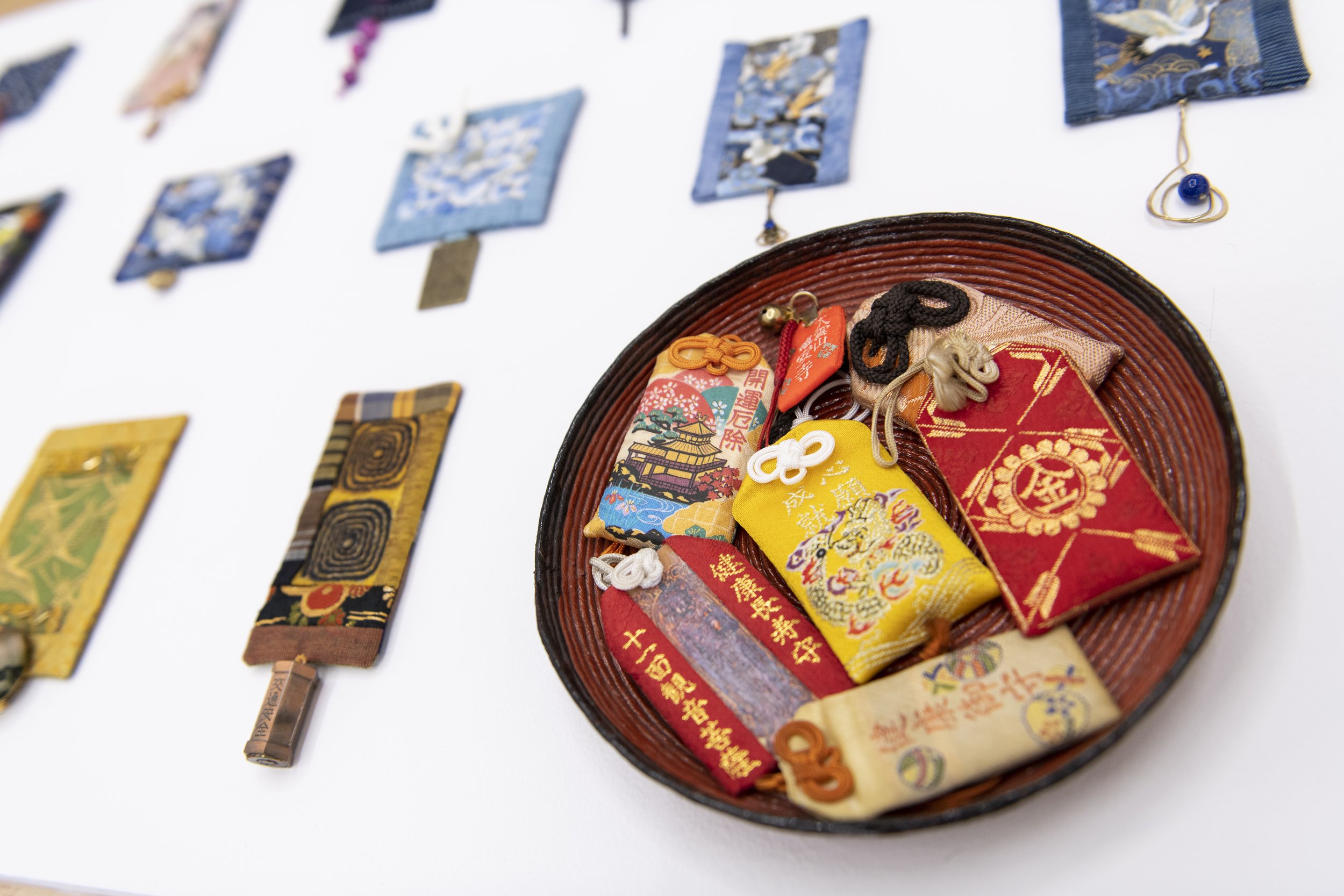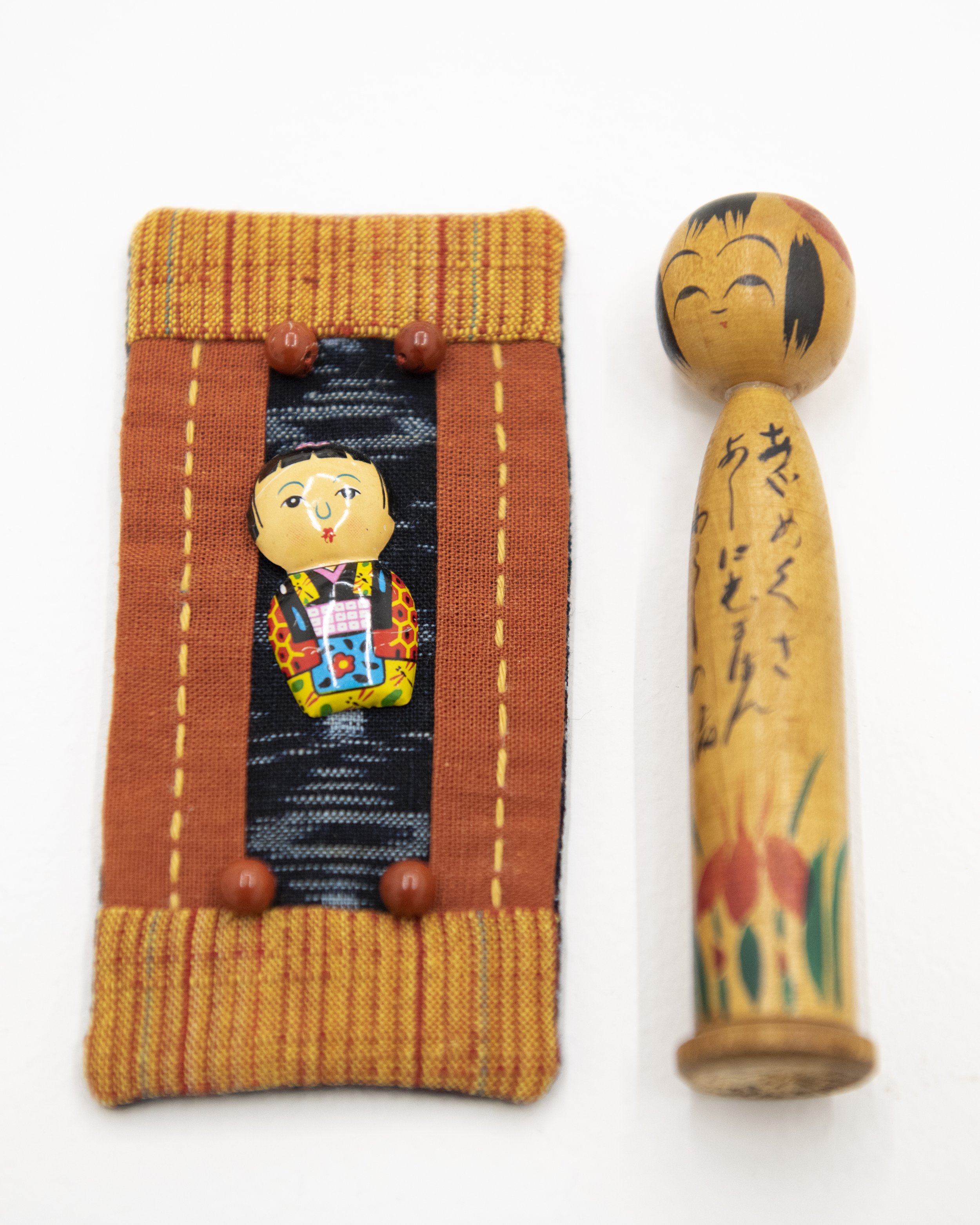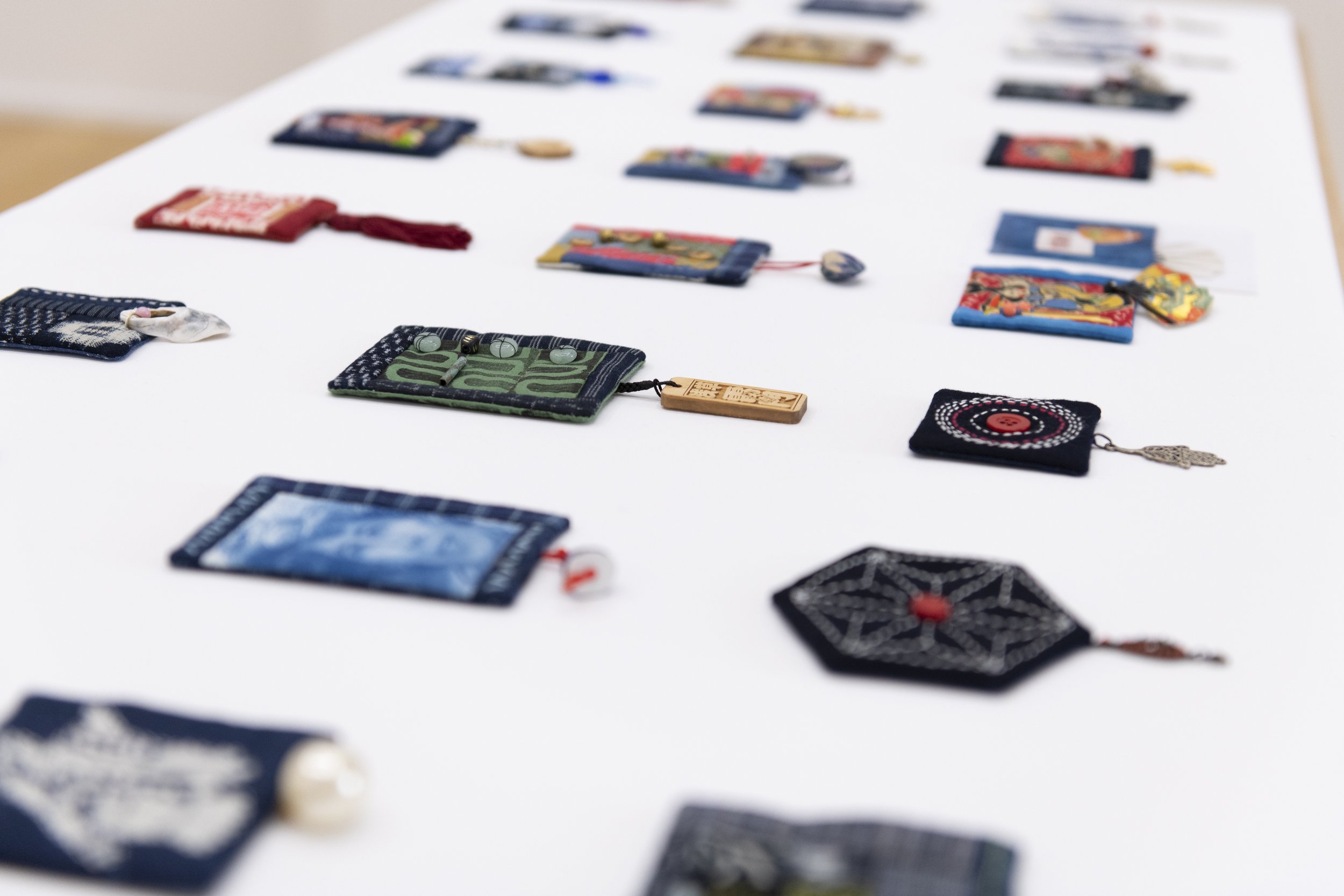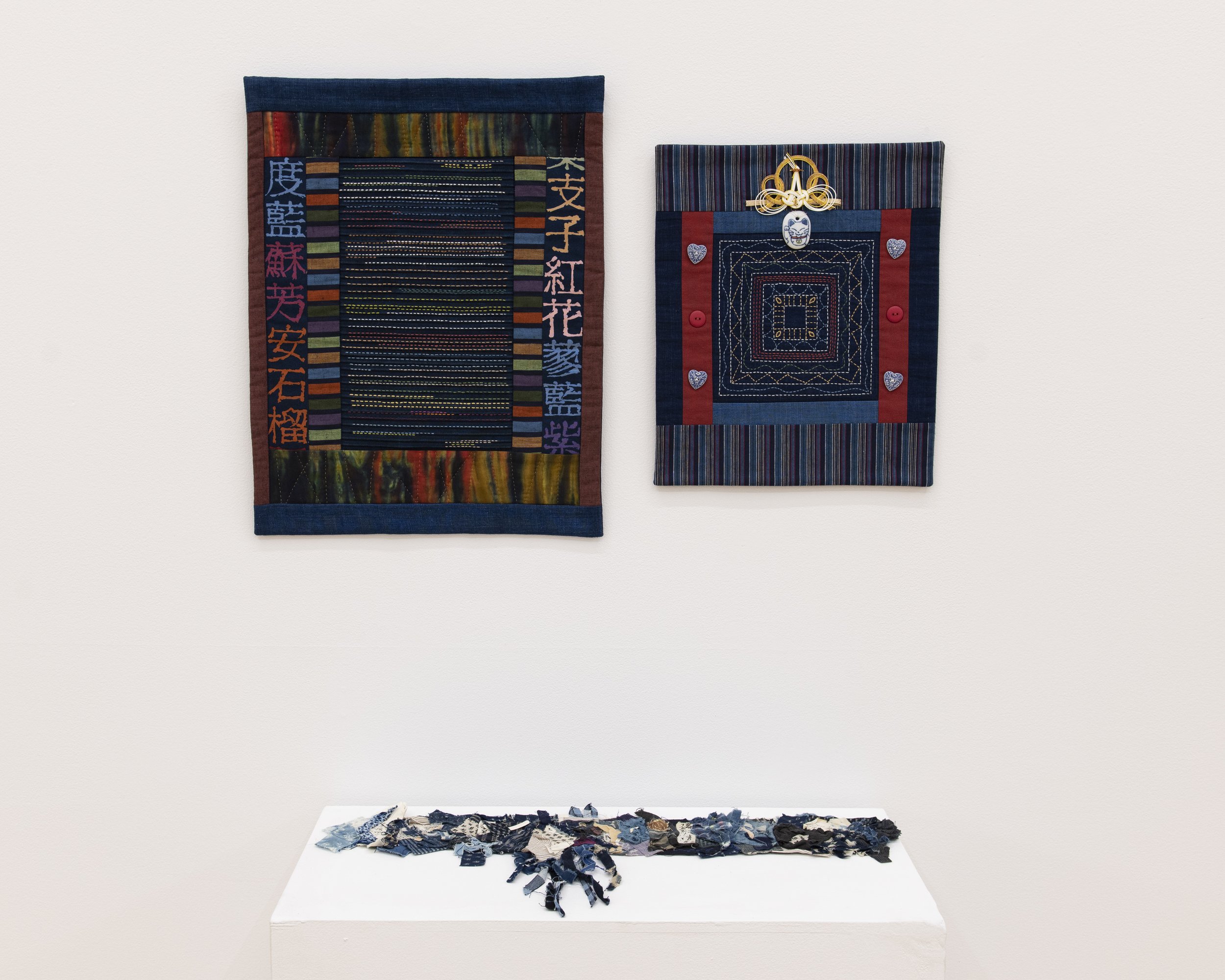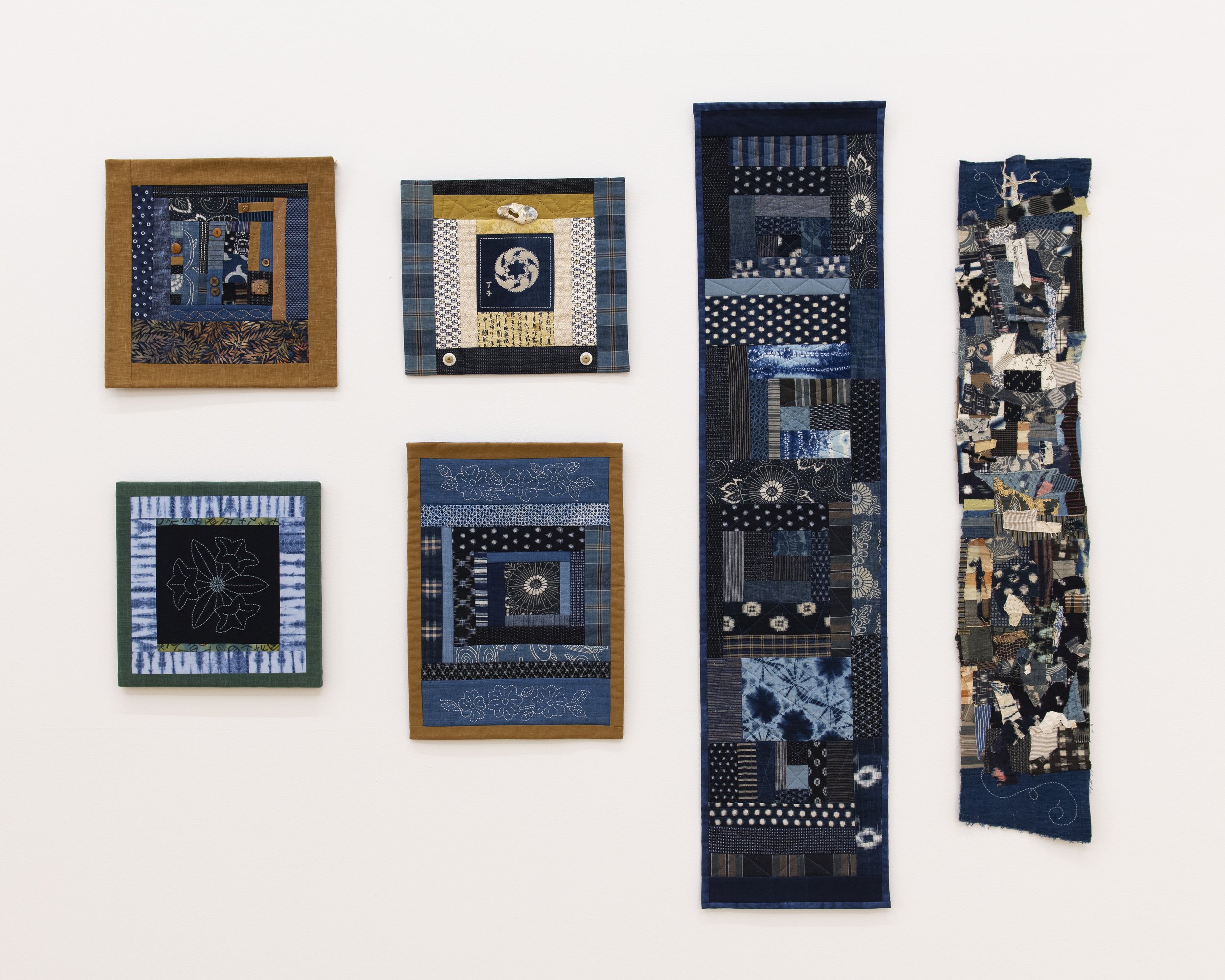Susan Ball Faeder
BLUE
January 27th – April 30th, 2022
MAB is pleased to present BLUE, an exhibition featuring mixed-media textile works by Susan Ball Faeder. On view are patchwork-quilts, fiber collages, rag weavings, Japanese sashiko-style embroideries, and works from Faeder’s 100 cloth amulets series. The title of the exhibition refers to indigo, a rich color with a distinct spirit and essence, often considered the mainstay of Japanese textiles. Cloth and culture naturally intertwine: Holding a piece of vintage indigo cloth in one’s hand can feel like a bullet train to the northern provinces of Japan, where winters are still harsh, and where not so very long ago (due to scarcity of materials and poverty) farmers and fishermen owned only one indigo-dyed cotton kimono. Such preciousness of fabric yielded an indigenous mending culture involving running stitches called sashiko. Layer upon layer of patching was lovingly stitched in place to prolong the life of a garment until the base merged with the mending. When it wore out, the tattered boro kimono was sliced into thin rag strips and woven into a new cloth, repurposed to yet another life. This mottainai or “waste nothing” spirit emerges in Faeder’s art as she respectfully honors the makers of Japanese indigo cloth by giving the small remnants one more lifetime. Whether as hand-stenciled yukata cotton, or the dyed and woven fabric that caresses a line of thread, or as a foundation to support other pieces of old cloth, Japanese indigo and the mending culture filters into each of the works on view at MAB. Faeder does not begin her works with a preset design or conceptual conceipt; instead, she trusts intuition while being attentive to line, color, balance, and content. She begins by threading a needle and reaching into her scrap basket to select a snippet of fabric to be appliquéd down or by coaxing a half-inch strip of tattered fabric through the loom’s warp with her fingers. The process, she says, is “a meditation of sorts, to be in the work is a practice of being present in the moment.”
The following is an essay by Susan Ball Faeder on her works in the exhibition
Eight of the ten fiber collage works in the “Boro Series”, constructed between 2005-2011, are featured in the BLUE exhibit at Milton Art Bank. As it sometimes happens, a few things came together at the same time: A) Across 15 years in business, I had somehow collected (aka couldn’t throw out) a LOT of very small Japanese vintage textile remnants, both from cutting fabric kits for my business and from my own projects using these kinds of fabrics. B) I happened upon an outdoor installation of large cloth banners adhered to nylon netting, purposefully hung outside to react “with” the natural environment. I was struck with how light traveled through the fabrics and how wind caused the large banners to bend and change shape. C) I needed a hand-sewing project for the 15-hour airplane ride to Japan in January 2005. D. The deadline: When Amy Katoh (owner of Blue & White shop) asked me what I was making, I told her I wasn’t sure yet where it was going. She asked if I could make six of these “whatevers” by July for a special exhibit in Tokyo. I said yes.
The full title of the series in Japanese is Arigato: Boro Boro Byobu. Let’s take this apart… Many people know that the Japanese word arigato means “thank you,” but to whom? In this case it represents my gratitude to the many people of Japan who informed me about the detailed process of making Japanese textiles, to the artisans who crafted these humble fabrics, and to the cloth itself.
Boro-boro is a uniquely Japanese concept that refers to a state of “being” with vague guidelines. When something (such as hand-spun, hand-woven cloth from an old kimono) reaches the level of boro-boro, it means the item is greatly worn and tattered from daily/ordinary use across many years. Likely it was repaired and patched many times, but it is no longer repairable and doesn’t offer much - if any - remaining value. Despite its weak physical appearance, however, both the spirit of the maker and the wearer linger; one might even hear a whispered melody between the threads. Holding the bits of cloth in the palm of our hands, we feel a sense of reverence for and connection to life in old Japan rise up. We shake our heads in sadness and mutter “mottainai, ne!” (“Such a waste!”), acknowledging the effort of the maker and its life of service in all its reincarnations. To save these otherwise seemingly useless bits cloth from the garbage bin, I created works allowing them “one more round,” so their individual voices could merge with their sisters’ and be appreciated just a little longer.
A byobu is a Japanese screen. Typically it is painted with flowers, birds, and seasonal landscapes of specific locations, but it could also portray a picture of interior life (such as kimono hanging on a rack), or famous battle scenes, or historic festivals. Screens can be used to decorate a wall, but also to divide a space, to create privacy, or mark a physical limit (don’t go past here). They come in various heights and sizes, and can be a single flat piece or have up to 6 folds, and sometimes come in pairs of sixes. For my “Boro Series”, byobu is a play on words as the work is constructed using nylon netting or “screening” as backing, hand sewing the cloth directly onto it. There is no batting or backing in the works; they are not quilts. They are translucent when hung near light. All ten pieces can be hung either horizontally or vertically as two-dimensional flat works, or bent or coaxed to soft 3D shapes. They can even be worn as adornment.
The works in this series have been exhibited in both Tokyo and New York, by invitation and by jury process, and featured in two catalogs. All work is by the artist, no assist.
A graduate of Bucknell University, Susan Ball Faeder is a nationally recognized teacher, lecturer, and fabric designer. Her work reveals a deliberate immersion in Eastern culture, as evidenced in her use of vintage Japanese textiles and their palette. She lived in Japan and studied the language and traditional culture firsthand for 50 years. In 1989, she started her own company, Quilters’ Express to Japan, as a vehicle for sharing her knowledge of Japanese culture through cloth arts. Through 30 textile tours to Japan, she provided participants with an insiders’ view, arranging personal meetings and workshops with fabric artisans. Her artwork has been exhibited nationally and internationally, including in New York City and Tokyo, and is held in private and corporate collections around the world. A publication featuring her set of 100 cloth amulets is forthcoming from Pretzel City Press. Faeder lives and works in Lewisburg, PA.
BLUE
VIRTUAL WALK-THROUGH

